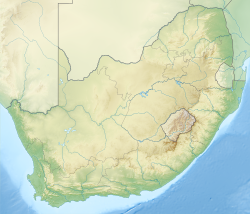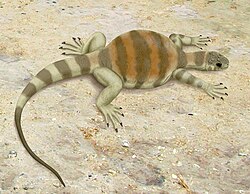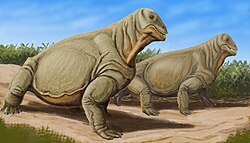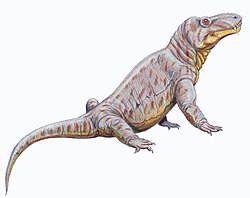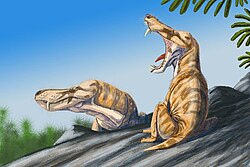| Abrahamskraal Formation | |
|---|---|
| Stratigraphic range: Wordian-Capitanian ~ | |
 Hill with outcropping Teekloof and Abrahamskraal Formations | |
| Type | Geological formation |
| Unit of | Beaufort Group |
| Sub-units | Tapinocephalus Assemblage Zone, Eodicynodon Assemblage Zone |
| Underlies | Teekloof Formation |
| Overlies | Ecca Group |
| Thickness | up to 2,565 m (8,415 ft) |
| Lithology | |
| Primary | Mudstone, sandstone |
| Other | Siltstone |
| Location | |
| Coordinates | 31°24′S23°06′E / 31.400°S 23.100°E |
| Approximate paleocoordinates | 59°54′S38°54′W / 59.9°S 38.9°W |
| Region | Northern, Western & Eastern Cape |
| Country | South Africa |
| Type section | |
| Named for | Abrahams Kraal 29 (farm), 18 km south of Leeu-Gamka |
| Named by | A.W. Keyser, P.J. Rossouw & Lieuwe Dirk Boonstra |
The Abrahamskraal Formation is a geological formation and is found in numerous localities in the Northern Cape, Western Cape, and the Eastern Cape of South Africa. It is the lowermost formation of the Adelaide Subgroup of the Beaufort Group, a major geological group that forms part of the greater Karoo Supergroup. It represents the first fully terrestrial geological deposits of the Karoo Basin. Outcrops of the Abrahamskraal Formation are found from the small town Middelpos in its westernmost localities, then around Sutherland, the Moordenaarskaroo north of Laingsburg, Williston, Fraserburg, Leeu-Gamka, Loxton, and Victoria West in the Western Cape and Northern Cape. In the Eastern Cape outcrops are known from Rietbron, north of Klipplaat and Grahamstown, and also southwest of East London. [1] [2]
